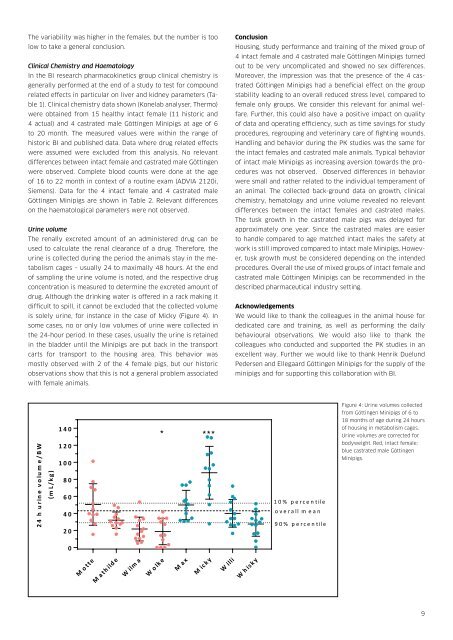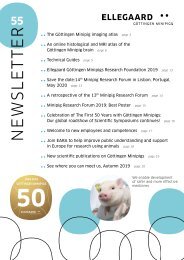Ellegaard_Minipigs_Newsletter_52
You also want an ePaper? Increase the reach of your titles
YUMPU automatically turns print PDFs into web optimized ePapers that Google loves.
The variability was higher in the females, but the number is too<br />
low to take a general conclusion.<br />
Clinical Chemistry and Haematology<br />
In the BI research pharmacokinetics group clinical chemistry is<br />
generally performed at the end of a study to test for compound<br />
related effects in particular on liver and kidney parameters (Table<br />
1). Clinical chemistry data shown (Konelab analyser, Thermo)<br />
were obtained from 15 healthy intact female (11 historic and<br />
4 actual) and 4 castrated male Göttingen <strong>Minipigs</strong> at age of 6<br />
to 20 month. The measured values were within the range of<br />
historic BI and published data. Data where drug related effects<br />
were assumed were excluded from this analysis. No relevant<br />
differences between intact female and castrated male Göttingen<br />
were observed. Complete blood counts were done at the age<br />
of 16 to 3<strong>52</strong>2 month in context of a routine exam (ADVIA 2120i,<br />
Siemens). Data for the 4 intact female and 4 castrated male<br />
Göttingen 30 <strong>Minipigs</strong> are shown in Table 2. Relevant differences<br />
on the haematological parameters were not observed.<br />
25<br />
W eight (kg)<br />
Urine volume<br />
The renally 20 excreted amount of an administered drug can be<br />
Conclusion<br />
Housing, study performance and training of the mixed group of<br />
4 intact female and 4 castrated male Göttingen <strong>Minipigs</strong> turned<br />
out to be very uncomplicated and showed no sex differences.<br />
Moreover, the impression was that the presence of the 4 castrated<br />
Göttingen <strong>Minipigs</strong> had a beneficial effect on the group<br />
stability leading to an overall reduced stress level, compared to<br />
female only groups. We consider this relevant for animal welfare.<br />
Further, this could also have a positive impact on quality<br />
of data and operating efficiency, such as time savings for study<br />
procedures, regrouping and veterinary care of fighting wounds.<br />
Handling and behavior during the PK studies was the same for<br />
the intact females and castrated male animals. Typical behavior<br />
of intact male <strong>Minipigs</strong> as increasing aversion towards the procedures<br />
was not observed. Observed differences in behavior<br />
were small and rather related to the individual temperament of<br />
an animal. The collected back-ground data on growth, clinical<br />
chemistry, hematology and urine volume revealed no relevant<br />
differences between the intact females and castrated males.<br />
The tusk growth in the castrated male pigs was delayed for<br />
approximately one year. Since the castrated males are easier<br />
to handle compared to age matched intact males the safety at<br />
work is still improved compared to intact male <strong>Minipigs</strong>. However,<br />
tusk growth must be considered depending on the intended<br />
used to calculate the renal clearance of a drug. Therefore, the<br />
15<br />
urine is collected during the period the animals stay in the metabolism<br />
cages – usually 24 to maximally 48 hours. At the end procedures. Overall the use of mixed groups of intact female and<br />
10<br />
of sampling the urine volume is noted, and the respective drug castrated male Göttingen <strong>Minipigs</strong> can be recommended in the<br />
concentration is measured to determine the excreted amount castrated of mdescribed ale pharmaceutical industry setting.<br />
5<br />
drug. Although the drinking water is offered in a rack making intact it fem ale<br />
difficult to spill, it cannot be excluded that the collected volume Acknowledgements<br />
0<br />
is solely urine, for instance in the case of Micky (Figure 4). In We would like to thank the colleagues in the animal house for<br />
2 4 6 8 10 12 14 16 18 20 22 24<br />
some cases, no or only low volumes of urine were collected in dedicated care and training, as well as performing the daily<br />
the 24-hour period. In these cases, usually Age (month) the urine is retained behavioural observations. We would also like to thank the<br />
in the bladder until the <strong>Minipigs</strong> are put back in the transport colleagues who conducted and supported the PK studies in an<br />
carts for transport to the housing area. This behavior was excellent way. Further we would like to thank Henrik Duelund<br />
mostly observed with 2 of the 4 female pigs, but our historic Pedersen and <strong>Ellegaard</strong> Göttingen <strong>Minipigs</strong> for the supply of the<br />
observations show that this is not a general problem associated minipigs and for supporting this collaboration with BI.<br />
with female animals.<br />
24 h urine volume/BW<br />
(m L/kg)<br />
140<br />
120<br />
100<br />
80<br />
60<br />
40<br />
20<br />
*<br />
***<br />
10% percentile<br />
overall m ean<br />
90% percentile<br />
Figure 4: Urine volumes collected<br />
from Göttingen <strong>Minipigs</strong> of 6 to<br />
18 months of age during 24 hours<br />
of housing in metabolism cages.<br />
Urine volumes are corrected for<br />
bodyweight. Red, intact female;<br />
blue castrated male Göttingen<br />
<strong>Minipigs</strong>.<br />
0<br />
M o tte<br />
M a th ild e<br />
W ilm a<br />
W o lk e<br />
M a x<br />
M ic k y<br />
W illi<br />
W h is k y<br />
9








